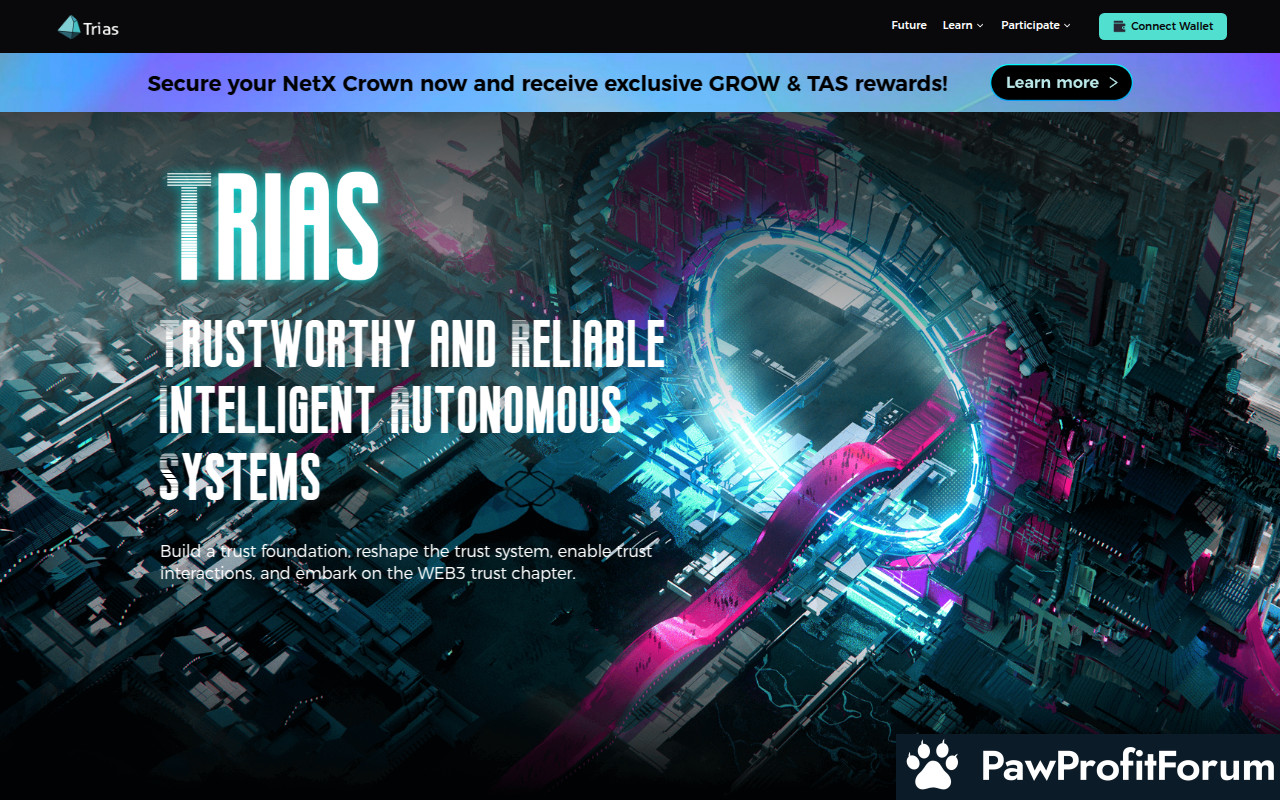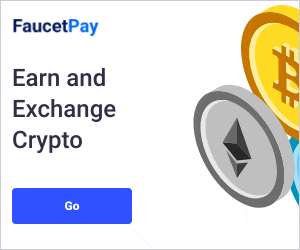Trustworthy and Reliable Intelligent Autonomous Systems
An all-platform-supported (Server, PC, Mobile, IoT, etc.) native-application-compatible smart contract execution platform, development framework and collaborating ecosystem. TRIAS aims to define a new-generation all-platform-supported public chain system. Trustworthy and Reliable Intelligent Autonomous Systems make people trust in machines.
The core objective of TRIAS is to establish Trustworthy and Reliable Intelligent Autonomous Systems, ensuring that users can trust machines and their operations. This is achieved through a robust public chain system that supports native applications and smart contracts, facilitating seamless integration and execution across different platforms.
In addition to its technological prowess, TRIAS serves as the utility token for the Trias network, playing a crucial role in the ecosystem's operations. It is traded on several exchanges, including Bitget, MEXC, Gate.io, KuCoin, and CoinEx, providing liquidity and accessibility to users.
The development framework of TRIAS is designed to foster collaboration and innovation, encouraging developers to build and deploy decentralized applications (dApps) efficiently. This collaborative ecosystem aims to drive the adoption of blockchain technology by offering a reliable and scalable infrastructure.
By focusing on creating a trustworthy environment for both users and machines, TRIAS addresses one of the critical challenges in the blockchain space: trust. This focus on trustworthiness and reliability sets TRIAS apart, making it a significant player in the evolving landscape of blockchain and decentralized technologies.
One of the standout features of TRIAS is its focus on Trustworthy and Reliable Intelligent Autonomous Systems. This concept revolves around creating a public chain system that users can trust to perform autonomously without the risk of tampering or unauthorized interference. The blockchain employs advanced cryptographic techniques and consensus algorithms to secure the network. These mechanisms are designed to prevent attacks from bad actors by ensuring that any changes to the blockchain require consensus from a majority of the network participants.
The consensus algorithm used by TRIAS is crucial in maintaining the integrity and security of the blockchain. By requiring multiple nodes to agree on the validity of transactions, the system can effectively prevent double-spending and other fraudulent activities. This decentralized approach ensures that no single entity has control over the entire network, making it more resilient to attacks.
In addition to its robust security features, TRIAS also emphasizes interoperability and scalability. The platform is designed to be compatible with various programming languages and development environments, making it easier for developers to create and deploy applications. This flexibility is further enhanced by the platform's ability to support smart contracts, which are self-executing contracts with the terms of the agreement directly written into code. Smart contracts enable automated, transparent, and tamper-proof transactions, which are essential for various applications, from financial services to supply chain management.
The development framework provided by TRIAS allows developers to build and deploy decentralized applications (dApps) efficiently. This framework includes a suite of tools and libraries that simplify the development process, enabling developers to focus on creating innovative solutions rather than dealing with the complexities of blockchain technology. The collaborating ecosystem further enhances this by providing a network of partners and resources that developers can leverage to bring their projects to fruition.
Another critical aspect of TRIAS is its decentralized cloud computing infrastructure. This infrastructure allows users to access computing resources on-demand, similar to traditional cloud services, but with the added benefits of decentralization. By distributing computing tasks across a network of nodes, TRIAS can offer more reliable and secure cloud computing services. This decentralized approach also reduces the risk of downtime and data breaches, as there is no single point of failure.
The platform's ability to support a wide range of devices, from servers to IoT systems, makes it highly versatile and suitable for various applications. For example, in the realm of IoT, TRIAS can provide secure and reliable communication between devices, ensuring that data is transmitted and processed without the risk of tampering. This capability is particularly important in industries such as healthcare, where the integrity and security of data are paramount.
TRIAS also aims to redefine the way people interact with machines by creating a system where users can trust the autonomous operations of devices. This vision is achieved through a combination of advanced technologies, including artificial intelligence and machine learning, which enable devices to make intelligent decisions based on real-time data. By integrating these technologies with its blockchain infrastructure, TRIAS can offer a comprehensive solution that addresses the needs of various industries and applications.
In addition to smart contracts, TRIAS serves as a development framework. This allows developers to create decentralized applications (dApps) that can run on multiple platforms seamlessly. By providing a robust and versatile framework, TRIAS aims to foster innovation and collaboration within the blockchain ecosystem.
Another significant application of TRIAS is in network payments. It can be used to facilitate transactions within its ecosystem, providing a secure and efficient means of transferring value. This is particularly useful in the financial industry, where TRIAS can offer a more secure platform for transactions and record-keeping, reducing the risk of fraud and enhancing transparency.
Staking is another key application of TRIAS. Users can stake their tokens to support the network's operations and, in return, earn rewards. This not only incentivizes participation but also helps maintain the network's security and stability. Governance is also an important aspect, as TRIAS token holders can participate in decision-making processes, influencing the future direction of the platform.
In the technology industry, TRIAS can be used for transaction fees and staking rewards. This ensures that the network remains sustainable and that participants are fairly compensated for their contributions. By integrating these various applications, TRIAS aims to create a trustworthy and reliable intelligent autonomous system that enhances the way people interact with machines and technology.
One of the pivotal moments for TRIAS was its migration from the old contract to a new contract. This transition was crucial for enhancing the token's functionality and security. Following this migration, TRIAS began trading on several major exchanges, including Bitget, MEXC, Gate.io, KuCoin, and CoinEx. This increased accessibility has been instrumental in expanding its user base and liquidity.
The development of TRIAS has been marked by its commitment to creating a robust smart contract execution platform and a comprehensive development framework. This ecosystem is designed to facilitate collaboration and innovation, making it easier for developers to create and deploy applications across various platforms.
TRIAS's focus on security and reliability is evident in its architecture, which aims to ensure that machines can be trusted to operate autonomously without human intervention. This is particularly important in an era where the Internet of Things (IoT) and other interconnected systems are becoming increasingly prevalent.
The token's journey has also been characterized by its efforts to build a strong community and foster partnerships with other blockchain projects. These collaborations are essential for driving adoption and integrating TRIAS into a broader technological landscape.
At the time of writing, TRIAS continues to trade actively on multiple exchanges, reflecting its ongoing relevance and potential in the cryptocurrency market.
An all-platform-supported (Server, PC, Mobile, IoT, etc.) native-application-compatible smart contract execution platform, development framework and collaborating ecosystem. TRIAS aims to define a new-generation all-platform-supported public chain system. Trustworthy and Reliable Intelligent Autonomous Systems make people trust in machines.
What is Trias Token (New)?
Trias Token (New) (TRIAS) stands out as a native-application-compatible smart contract execution platform, development framework, and collaborating ecosystem. It aims to redefine blockchain technology by creating a trustworthy and reliable decentralized cloud computing infrastructure. TRIAS supports all platforms, including servers, PCs, mobile devices, and IoT, making it versatile and adaptable to various technological environments.The core objective of TRIAS is to establish Trustworthy and Reliable Intelligent Autonomous Systems, ensuring that users can trust machines and their operations. This is achieved through a robust public chain system that supports native applications and smart contracts, facilitating seamless integration and execution across different platforms.
In addition to its technological prowess, TRIAS serves as the utility token for the Trias network, playing a crucial role in the ecosystem's operations. It is traded on several exchanges, including Bitget, MEXC, Gate.io, KuCoin, and CoinEx, providing liquidity and accessibility to users.
The development framework of TRIAS is designed to foster collaboration and innovation, encouraging developers to build and deploy decentralized applications (dApps) efficiently. This collaborative ecosystem aims to drive the adoption of blockchain technology by offering a reliable and scalable infrastructure.
By focusing on creating a trustworthy environment for both users and machines, TRIAS addresses one of the critical challenges in the blockchain space: trust. This focus on trustworthiness and reliability sets TRIAS apart, making it a significant player in the evolving landscape of blockchain and decentralized technologies.
What is the technology behind Trias Token (New)?
Trias Token (New) (TRIAS) operates on a sophisticated layer-1 blockchain that serves as a decentralized cloud computing infrastructure. This blockchain is designed to provide trustworthy and reliable cloud computing services for a wide range of applications. At its core, the technology behind TRIAS is a native-application-compatible smart contract execution platform, a development framework, and a collaborating ecosystem. This multifaceted approach ensures that the platform can support various devices, including servers, PCs, mobile devices, and IoT systems.One of the standout features of TRIAS is its focus on Trustworthy and Reliable Intelligent Autonomous Systems. This concept revolves around creating a public chain system that users can trust to perform autonomously without the risk of tampering or unauthorized interference. The blockchain employs advanced cryptographic techniques and consensus algorithms to secure the network. These mechanisms are designed to prevent attacks from bad actors by ensuring that any changes to the blockchain require consensus from a majority of the network participants.
The consensus algorithm used by TRIAS is crucial in maintaining the integrity and security of the blockchain. By requiring multiple nodes to agree on the validity of transactions, the system can effectively prevent double-spending and other fraudulent activities. This decentralized approach ensures that no single entity has control over the entire network, making it more resilient to attacks.
In addition to its robust security features, TRIAS also emphasizes interoperability and scalability. The platform is designed to be compatible with various programming languages and development environments, making it easier for developers to create and deploy applications. This flexibility is further enhanced by the platform's ability to support smart contracts, which are self-executing contracts with the terms of the agreement directly written into code. Smart contracts enable automated, transparent, and tamper-proof transactions, which are essential for various applications, from financial services to supply chain management.
The development framework provided by TRIAS allows developers to build and deploy decentralized applications (dApps) efficiently. This framework includes a suite of tools and libraries that simplify the development process, enabling developers to focus on creating innovative solutions rather than dealing with the complexities of blockchain technology. The collaborating ecosystem further enhances this by providing a network of partners and resources that developers can leverage to bring their projects to fruition.
Another critical aspect of TRIAS is its decentralized cloud computing infrastructure. This infrastructure allows users to access computing resources on-demand, similar to traditional cloud services, but with the added benefits of decentralization. By distributing computing tasks across a network of nodes, TRIAS can offer more reliable and secure cloud computing services. This decentralized approach also reduces the risk of downtime and data breaches, as there is no single point of failure.
The platform's ability to support a wide range of devices, from servers to IoT systems, makes it highly versatile and suitable for various applications. For example, in the realm of IoT, TRIAS can provide secure and reliable communication between devices, ensuring that data is transmitted and processed without the risk of tampering. This capability is particularly important in industries such as healthcare, where the integrity and security of data are paramount.
TRIAS also aims to redefine the way people interact with machines by creating a system where users can trust the autonomous operations of devices. This vision is achieved through a combination of advanced technologies, including artificial intelligence and machine learning, which enable devices to make intelligent decisions based on real-time data. By integrating these technologies with its blockchain infrastructure, TRIAS can offer a comprehensive solution that addresses the needs of various industries and applications.
What are the real-world applications of Trias Token (New)?
Trias Token (New) (TRIAS) is a cryptocurrency designed to support a wide range of applications across various platforms, including servers, PCs, mobile devices, and IoT (Internet of Things) devices. One of its primary real-world applications is as a smart contract execution platform. This means it can facilitate and enforce the terms of contracts automatically, without the need for intermediaries, making transactions more efficient and secure.In addition to smart contracts, TRIAS serves as a development framework. This allows developers to create decentralized applications (dApps) that can run on multiple platforms seamlessly. By providing a robust and versatile framework, TRIAS aims to foster innovation and collaboration within the blockchain ecosystem.
Another significant application of TRIAS is in network payments. It can be used to facilitate transactions within its ecosystem, providing a secure and efficient means of transferring value. This is particularly useful in the financial industry, where TRIAS can offer a more secure platform for transactions and record-keeping, reducing the risk of fraud and enhancing transparency.
Staking is another key application of TRIAS. Users can stake their tokens to support the network's operations and, in return, earn rewards. This not only incentivizes participation but also helps maintain the network's security and stability. Governance is also an important aspect, as TRIAS token holders can participate in decision-making processes, influencing the future direction of the platform.
In the technology industry, TRIAS can be used for transaction fees and staking rewards. This ensures that the network remains sustainable and that participants are fairly compensated for their contributions. By integrating these various applications, TRIAS aims to create a trustworthy and reliable intelligent autonomous system that enhances the way people interact with machines and technology.
What key events have there been for Trias Token (New)?
Trias Token (New) (TRIAS) represents a significant advancement in blockchain technology, aiming to create a trustworthy and reliable intelligent autonomous system. This system supports all platforms, including servers, PCs, mobile devices, and IoT, and is compatible with native applications. TRIAS seeks to establish a new-generation public chain system that allows people to trust machines.One of the pivotal moments for TRIAS was its migration from the old contract to a new contract. This transition was crucial for enhancing the token's functionality and security. Following this migration, TRIAS began trading on several major exchanges, including Bitget, MEXC, Gate.io, KuCoin, and CoinEx. This increased accessibility has been instrumental in expanding its user base and liquidity.
The development of TRIAS has been marked by its commitment to creating a robust smart contract execution platform and a comprehensive development framework. This ecosystem is designed to facilitate collaboration and innovation, making it easier for developers to create and deploy applications across various platforms.
TRIAS's focus on security and reliability is evident in its architecture, which aims to ensure that machines can be trusted to operate autonomously without human intervention. This is particularly important in an era where the Internet of Things (IoT) and other interconnected systems are becoming increasingly prevalent.
The token's journey has also been characterized by its efforts to build a strong community and foster partnerships with other blockchain projects. These collaborations are essential for driving adoption and integrating TRIAS into a broader technological landscape.
At the time of writing, TRIAS continues to trade actively on multiple exchanges, reflecting its ongoing relevance and potential in the cryptocurrency market.
Who are the founders of Trias Token (New)?
Trias Token (New) (TRIAS) stands for Trustworthy and Reliable Intelligent Autonomous Systems, aiming to redefine public chain systems across various platforms. The founders of Trias Token (New) are Ruan Anbang and Wei Ming. Ruan Anbang brings a wealth of experience in cybersecurity and blockchain technology, playing a pivotal role in the conceptualization and development of TRIAS. Wei Ming, with a strong background in software engineering and system architecture, complements the team by focusing on the technical execution and scalability of the platform. Their combined expertise drives the vision of creating a secure and reliable ecosystem for smart contract execution.| Website | www.trias.one/ |
| Socials | twitter.com/triaslab |
| Socials | t.me/triaslab |
| Contracts | 0x3A85...48e95d |
| Audits | https://cmc.certik-skynet.com/redirect?project=trias |
| Explorers | etherscan.io/token/0x3A856d4effa670C54585a5D523e96513e148e95d |
| Wallets | metamask.io/ |










